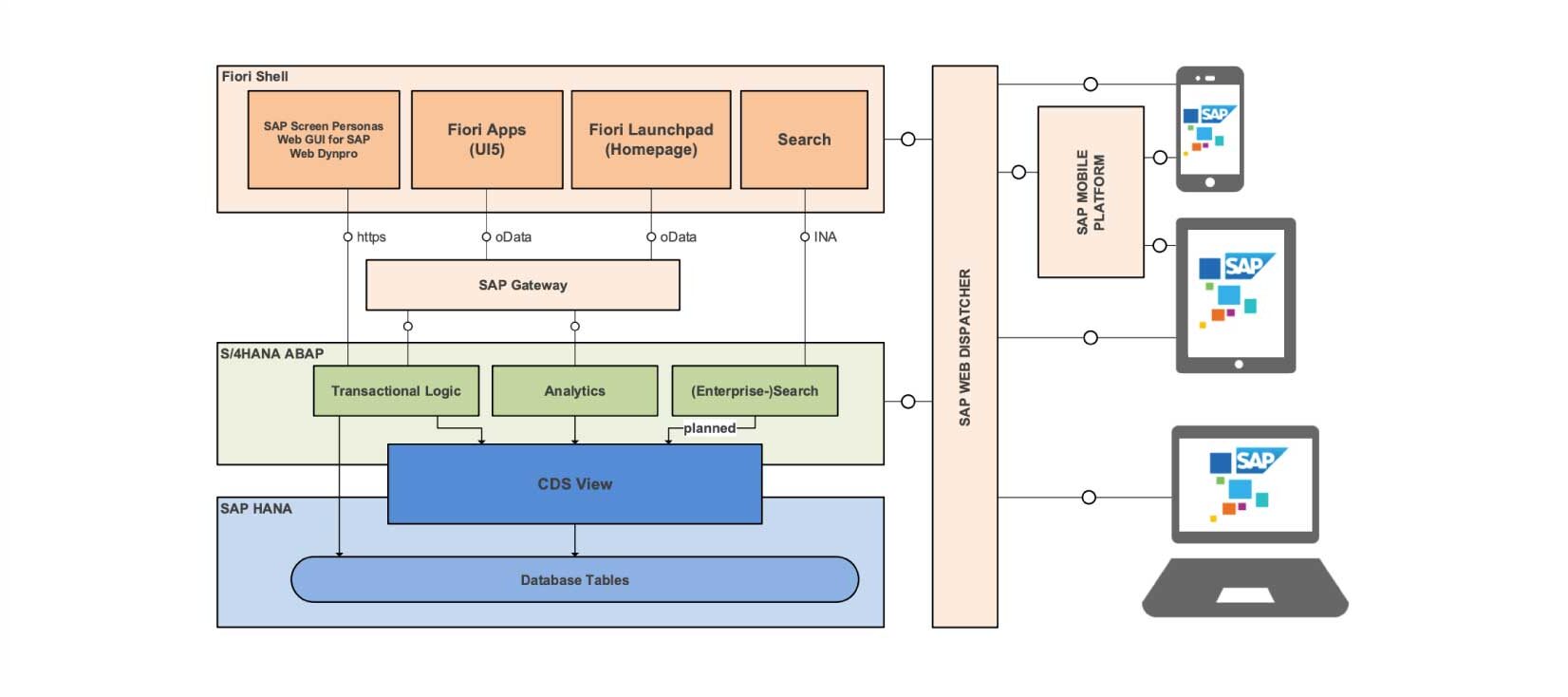SAP S/4HANA Architecture: A Complete Guide

Contents
Contents
1. Evolution of S/4HANA
Brief History of SAP
SAP is a pioneer in the enterprise software world. SAP R/2 broke new ground in the 1970s by offering a real-time data processing solution. As technology evolved, so did SAP, introducing R/3 in the 1990s. This version was revolutionary, bringing client-server architecture to the forefront, and it set a new standard for enterprise resource planning (ERP) systems. However, the digital landscape continued to evolve, demanding more agility and real-time processing capabilities. This led to the development of SAP HANA, a game-changing in-memory database, and it laid the foundation for the next leap: S/4HANA.
Key Developments Leading to S/4HANA
The leap from SAP HANA to S/4HANA was marked by significant technological advancements. The architecture of S/4HANA, distinct from its predecessors, is built on three layers: the database, application and presentation layers.

This design not only enhances data processing speeds, but also streamlines cloud integration, which is crucial in today’s cloud-centric world. S/4HANA stands out thanks to its ability to efficiently handle large volumes of data. This is vital for organizations dealing with ever-increasing data pools.
SAP S/4HANA also marks a shift from traditional database models to a more simplified one. This reduces the data footprint and allows for real-time analytics and applications to run side by side on the same data. This shift has a profound impact on cloud security and risk management, allowing businesses to quickly respond to security incidents and effectively manage vulnerabilities.
2. Core Components of S/4HANA Architecture
In-Memory Computing Engine
SAP HANA, the powerhouse at the heart of S/4HANA, revolutionized data processing in the enterprise world. As an in-memory computing engine, it allows for lightning-fast processing of large volumes of data, a stark contrast to traditional database systems. This speed is not just a matter of efficiency; it’s a game-changer for businesses that rely on real-time data analysis for decision-making. In the context of cloud security, users can identify and mitigate threats much faster, significantly reducing the attack surface and enhancing the overall security posture.
Incorporating SAP HANA into your business processes, especially through services like SAP Cloud Migration, ensures improved performance and fortified security in your cloud environments. This is crucial, as data breaches and cyberattacks are becoming increasingly sophisticated.
Modern Design: Fiori UX
The introduction of Fiori UX in S/4HANA marks a significant change in SAP’s approach to user experience. Gone are the days of clunky, hard-to-navigate interfaces. Fiori offers a clean, intuitive and personalized user experience, dramatically improving usability and efficiency. This modern approach is not just about aesthetics; it plays a crucial role in ensuring that security policies are more accessible and understandable to users, thereby reducing the risk of error.
Advanced Analytics and Real-Time Data Processing
The advanced processing capabilities of S/4HANA set it apart in the realm of enterprise resource planning. Thanks to its ability to handle complex computations and analytics in real time, S/4HANA provides businesses with insights that were previously unattainable. This is particularly beneficial for security teams who rely on real-time data to identify and remediate cybersecurity threats.
Furthermore, the integration of advanced analytics in S/4HANA improves risk management and helps establish quantitative benchmarks for security metrics. For companies looking to optimize their security measures, S/4HANA’s processing power can be transformative.
3. Exploring S/4HANA Architecture: Insights and Benefits
Understanding the Architecture of S/4HANA
If you dive deeper into the architecture of S/4HANA, it’s evident that it was designed to meet the dynamic needs of modern businesses. The three-layer architecture – consisting of the database, application and presentation layers – offers unparalleled efficiency. This design facilitates faster data processing and enhanced cybersecurity. By enabling real-time monitoring and response, S/4HANA helps security teams manage the ever-growing attack surface in cloud environments and ensure the protection of sensitive data.
Comparing ECC and S/4HANA Architecture
The difference between ECC and S/4 HANA architecture is like comparing a classic car to a modern sports car. ECC was built on a traditional database and served its purpose well for its time. However, S/4HANA, with its in-memory computing, represents a significant leap in efficiency and capabilities. This difference is particularly noticeable in areas like cloud security metrics, risk management and cloud computing.

Role of S/4HANA in Cloud Security
In today’s cloud-centric world where cybersecurity and data protection are paramount, S/4HANA plays a crucial role. Its advanced architecture and real-time data processing capabilities enable organizations to strengthen their security posture. It allows security teams to implement robust security measures, perform thorough risk assessments and ensure continuous improvement to their security programs.
Moreover, S/4HANA’s architecture facilitates the effective management of workloads in cloud environments. By optimizing access control and enhancing security awareness, teams can mitigate risks associated with cloud services, such as DDoS attacks and phishing.
4. S/4HANA Deployment Options
 On-premise vs. Cloud vs. Hybrid
On-premise vs. Cloud vs. Hybrid
Navigating the world of S/4HANA deployment can be confusing. Each option – on-premise, cloud and hybrid – offers a unique set of features and benefits.
- On-premise deployment provides analogous to having complete control over the process. It offers advanced customization options and a high degree of control over your environment and data. It’s ideal for organizations with stringent data security requirements or those that prefer to manage their infrastructure in-house.
- With cloud deployment, SAP manages everything, from infrastructure to software updates. It’s a great fit for businesses looking for scalability, cost-effectiveness and quick deployment. Cloud environments also offer the benefit of quickly adapting to security threats, thanks to cloud providers’ expertise in cybersecurity.
- Hybrid models offer the best of both worlds. They blend the control and customization of on-premise deployment with the flexibility and scalability of the cloud. This model is perfect for organizations that want to maintain core processes on-premise while leveraging the cloud for other aspects of their business.
Each of these models comes with its benefits and disadvantages, and the choice largely depends on your organization’s size, needs and capabilities.
Pros and Cons of Each Model
Understanding the advantages and limitations of each model is crucial to make an informed decision.
On-premise
- Pros: Complete control over the environment, increased customization and data security. It’s suited for companies that have invested in on-premise infrastructure.
- Cons: Higher upfront costs, more resources required for maintenance and challenges in scalability and agility.
Cloud
- Pros: Lower initial costs, easy scalability and no need for physical maintenance of infrastructure. You have access to the latest software updates and security measures.
- Cons: Less control over the environment and lower data security, although cloud providers typically offer robust security measures.
Hybrid
- Pros: Flexibility to choose which processes to run on-premise and which in the cloud, offering a balance between control and scalability.
- Cons: This can be more complex to manage due to the integration of different environments, and it might require sophisticated coordination between cloud and on-premise infrastructures.
Understanding these deployment options is crucial to optimize your operations and align them with your organization’s goals. Whether it’s enhancing your security posture in cloud environments or managing sensitive data, each model offers different ways to achieve these objectives.
Choosing the right S/4HANA deployment model is a strategic decision that can significantly impact your business. It’s not just about where your data resides, but how effectively you can leverage S/4HANA’s powerful capabilities to enhance your operations and cybersecurity framework.
5. Integration Capabilities
Seamless Integration with Other Systems
Think of S/4HANA as a central hub in a vast network. S/4HANA is designed to seamlessly connect with a variety of external systems, including third-party applications and legacy systems. This interoperability is crucial for businesses that operate with a diverse set of tools and technologies.
- Third-Party Applications: S/4HANA integrates smoothly with numerous third-party applications, enhancing its functionality and versatility. This integration allows businesses to leverage best-of-breed solutions across different domains, whether it’s CRM, supply chain management or human resources. This flexibility allows companies to adapt to changing needs without being constrained by their core ERP system.
- Legacy Systems: For many organizations, abandoning legacy systems is neither feasible nor desirable. S/4HANA acknowledges this reality by offering robust integration capabilities. This means businesses can transition to more modern, efficient processes without losing the value embedded in their existing systems.
Incorporating S/4HANA into your business technology stack can be a significant step toward digital transformation.
Enhanced User Experience and Business Processes
The integration capabilities of S/4HANA extend beyond just connecting systems; they also play a vital role in enhancing the user experience and optimizing business processes.
- User Experience: By integrating with applications like SAP Fiori, S/4HANA offers a more intuitive and user-friendly interface. This modern UI simplifies complex processes, making them more accessible to the end user and increasing efficiency and productivity.
- Optimized Business Processes: The real-time data model of S/4HANA, combined with its integration capabilities, allows for more streamlined and automated business processes. This integration results in faster decision-making, improved data accuracy and enhanced efficiency. It’s not just about having data; it’s about having the right data at the right time.
For those looking to embark on this integration journey, Redwood’s article on how RunMyJobs’ S/4HANA integration brings deeper automation to SAP customers.
6. Customization and Scalability
Tailoring S/4HANA to Fit Your Needs
S/4HANA’s architecture is inherently flexible, allowing businesses to mold it according to their needs. This customization is applicable to your whole company, whether it’s finance, human resources, supply chain management or customer relationship management.
- Functionality: Through a range of add-ons and Fiori apps, businesses can modify S/4HANA to meet their specific needs. Whether it’s refining procurement processes or streamlining the human resources department, S/4HANA’s modular design makes it possible.
- User Experience: S/4HANA goes beyond functional customization by offering a user interface that can be tailored for individual roles and preferences. With SAP Fiori, users benefit from an intuitive, streamlined experience, ensuring that the system is powerful and simple to use.
For organizations embarking on this customization journey, exploring options like Job Scheduling from RunMyJobs can provide valuable insights and tools for successful deployment.
Scalability Features
S/4HANA is about meeting today’s needs and being equipped for tomorrow’s growth. Its scalability is one of its most compelling features.
- Elasticity: As your business expands, S/4HANA grows with you. Whether it’s increasing the number of users, processing more transactions or adding new functionalities, S/4HANA can effortlessly handle it all.
- Performance: With its in-memory database, S/4HANA ensures excellent performance, even with a high workload. This means businesses can process large volumes of data in real time, enabling quick decision-making and efficient operations.
For businesses looking at scalability, services like the RISE with SAP can be beneficial. This ensures that your ERP system grows along with your business.
7. Migrating to S/4HANA
Key Considerations Before Migrating
Migrating to S/4HANA is a significant step for any business. Like any journey, preparation is key. Here are some crucial considerations:
- Assess Needs: Understand what you want to achieve with S/4HANA. Is it enhanced efficiency, better data management or digital transformation? Your goals will shape your migration path.
- Understand the Current Landscape: Evaluate your existing systems, whether it’s SAP ERP or SAP ECC. Understanding your situation is critical for a smooth transition.
- Ensure Clean Data: Data is the foundation of any ERP system. Ensure your data is clean and well-managed before migrating to S/4HANA. This may involve data simplification and ensuring compatibility with the new system’s structure.
- Choose the Right Approach: Whether it’s a greenfield implementation, a brownfield approach or something in between, the migration method will significantly impact your strategy.
- Train Team: Migrating to a new system requires adapting to new workflows and interfaces, like SAP Fiori. Prepare your team with adequate training and support.
Get more guidance on embarking on the RISE with SAP with this valuable resource from Redwood.

Migration Steps
The migration to S/4HANA involves several key steps:
- Planning: This initial phase involves setting clear objectives, creating a roadmap and preparing your organization for the change. It includes understanding the architecture of SAP S/4HANA and how it differs from your current system.
- Technical Assessment and System Setup: Evaluate your existing technical landscape and prepare the necessary infrastructure for S/4HANA. This may involve decisions regarding cloud vs. on-premise setups and understanding the capabilities of the SAP HANA database.
- Custom Code Remediation: If you have existing ABAP code in your SAP systems, you will need to review and perhaps adapt it to ensure compatibility with S/4HANA.
- Data Migration and Testing: Migrate your data to the new system and perform extensive testing to ensure everything works as expected. This stage is crucial for data integrity and system reliability.
- Go-Live and Post-Go-Live Support: Once everything is tested and ready, it’s time to go live with S/4HANA. Post-go-live support is crucial to resolve any issues and ensure smooth operations.
For those considering a system conversion or a complete overhaul, Redwood’s article on bringing your SAP processes into the future is an excellent guide.
8. Challenges and Considerations
 The Challenges of Adopting S/4HANA
The Challenges of Adopting S/4HANA
Adopting S/4HANA, like any major transformation, comes with its set of challenges. Understanding them is crucial to successfully navigate them.
- Complexity: Transitioning from traditional SAP ERP or SAP ECC systems to the advanced S/4HANA can be complex, especially considering the differences in architecture and data models. The complexity increases if your existing system includes customizations or unique processes.
- Data Management and Quality: Ensuring data integrity and quality during migration is crucial. This involves cleansing, deduplication and proper alignment with the new data structures in S/4HANA.
- Change Management: Adopting S/4HANA often requires significant changes in business processes and workflows. Managing this change effectively, from training users to adapting internal processes, is key.
- Technical Expertise: Implementing S/4HANA requires specific skills and knowledge, especially when it comes to its high-performance in-memory database, SAP HANA, and its advanced applications, such as machine learning and AI.
- Cost and ROI Concerns: Determining the cost-effectiveness and projecting the return on investment can be challenging.
Overcoming the Challenges of Adopting S/4HANA
Here are some strategies to overcome these challenges:
- Strategic Planning and Phased Approach: Adopt a strategic planning process that includes a phased migration approach. This can involve starting with a pilot project or specific modules before full-scale implementation.
- Focus on Data Quality: Prioritize data cleansing and management. Using tools and services that automate and simplify data migration can be beneficial.
- Effective Change Management: Develop comprehensive change management strategies that include extensive training and support for end users. Refer to resources, like our S/4HANA integration guides, to help your team adapt to the new system.
- Leverage Expertise: Partner with experienced vendors or consultants who have a proven track record in S/4HANA implementations. This will give you access to the necessary expertise and insights.
- Cost-Benefit Analysis: Conduct a thorough cost-benefit analysis to understand the ROI. Consider both direct and indirect benefits, including long-term efficiency gains and competitive advantages.
- Stay Informed: Keep up with the latest developments and best practices around S/4HANA. Engaging in continuous learning and community forums can provide valuable insights.
While implementing S/4HANA can be challenging, careful planning, proper resources and expert guidance will help you succeed. When considering how the platform works with job scheduling, Redwood offers valuable resources and expertise that can assist. Embarking on the RISE with SAP can help your organization navigate these challenges and harness the full potential of S/4HANA.
9. Future of S/4HANA
Trends and Updates
Over time, S/4HANA will continue to be dynamic and transformative. Looking ahead, several trends and updates are likely to shape its trajectory:
- Enhanced Integration: You can expect S/4HANA to further integrate with cutting-edge technologies like AI and machine learning. This integration will automate more processes and provide new efficiencies to SAP ERP systems.
- Focus on User Experience: SAP Fiori, known for its user-friendly interface, will continue to evolve, offering a more personalized and intuitive experience. This will enhance user engagement and productivity across various business applications.
- Advanced Data Management Capabilities: The SAP HANA database, the backbone of S/4HANA, is likely to see enhancements in handling vast data sets, offering more robust data services and analytics capabilities.
- Cloud-First Approach: As businesses continue to embrace digital transformation, S/4HANA’s journey into the cloud is expected to accelerate. This shift will emphasize scalability, security and flexibility, meeting a range of needs and enabling seamless system conversion and migration strategies.
S/4HANA in the ERP World
S/4 HANA will continue to play a crucial role in the ERP world. The future looks bright:
- Digital Transformation: S/4HANA is set to become even more central to digital transformation initiatives. Its ability to provide a comprehensive, integrated suite for business technology platforms positions it as a pivotal player in modernizing processes.
- Seamless Integration and Compatibility: With its modular design and compatibility features, S/4HANA will continue to be crucial in integrating various departments, from supply chain management (SCM) to customer relationship management (CRM), ensuring cohesive and unified operations.
- Innovation: The future of S/4HANA is about enabling businesses to manage their current operations and to innovate and adapt to future challenges. Through continuous enhancements and updates, it will support new business models and practices, enabling organizations to stay ahead in a rapidly evolving market.
- Sustainability and Scalability: As sustainability becomes a core business focus, S/4HANA will incorporate features that support sustainable business practices. Additionally, its scalability will make it a go-to solution for businesses of all sizes, from startups to large enterprises.
As we’ve seen, S/4HANA is more than just another SAP ERP solution. It’s a cornerstone for businesses and for those seeking digital transformation, S/4HANA can offer a harmonious blend of automation, advanced data services and user-centric design. The transition from traditional systems, like SAP ECC, to the more advanced S/4HANA, with its high-performance SAP HANA database and machine learning integration, represents a new era of technology.
Whether you’re looking to enhance your current SAP Business Suite, explore new uses or embark on a S/4HANA migration, the architecture of S/4HANA is designed to meet your business’s ever-changing needs, ensuring compatibility with current and future technologies. The journey from your existing system to this new platform, whether it’s through a greenfield or brownfield approach, is a journey of simplification, efficiency and innovation.
For businesses considering such a decision, sign up for a RunMyJobs demo today and see how S/4HANA can transform your business process automation in the digital age!